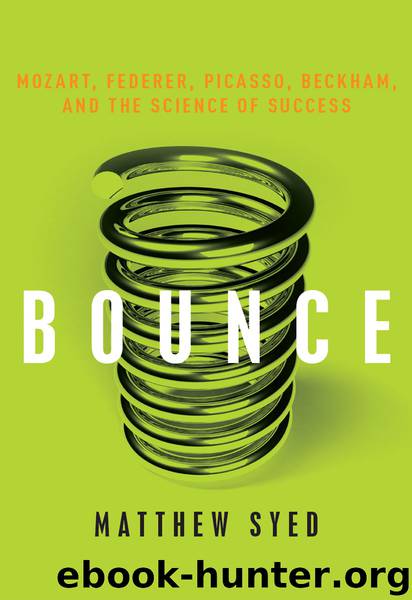Bounce by Matthew Syed

Author:Matthew Syed
Language: eng
Format: epub, mobi
Publisher: HarperCollins
Published: 2009-11-06T16:00:00+00:00
The Placebo Effect in Sports
In 1952 Norman Vincent Peale, a Protestant preacher, wrote what was to become arguably the single most important work of popular psychology of the twentieth century. Its title: The Power of Positive Thinking. It spent 186 straight weeks on the New York Times best-seller list and sold more than five million copies worldwide.
In the book, Peale tells the reader of the power of religious belief to heal, urging the reader to develop religious conviction through the techniques of imagery, affirmations, and reading the Bible. But Peale, despite his Protestant background, also makes it clear that the reader’s religious background is irrelevant to the success of positive thinking. “It’s not necessary to be born again,” Peale said. “You have your way to God; I have mine…. Christ is just one of the ways.”
Peale was, in effect, articulating the placebo effect: he was saying that it is belief itself, not its content, that matters. As Harrington puts it: “Peale actually probably spent more time than any other twentieth-century figure in the mind-cure movement downplaying the need to commit to any specific Christian or other specific faith tradition to enjoy the healing fruits of faith.” It is hardly surprising that he was, for this reason, condemned by many within the Christian community.
But the genius of Peale’s book lay in its recognition that the religious placebo (or, to use his words, the power of religious belief) extends far beyond the realm of health. He realized that it can also reduce anxiety, improve one’s sense of belonging, boost self-confidence, and alleviate angst—all things that can, as Peale points out again and again, improve life and radically transform performance. Chapters in Peale’s book include “Believe in Yourself,” “Expect the Best and Get It,” “I Don’t Believe in Defeat,” and “How to Draw on That Higher Power.”
But it was in sport that the book arguably had its greatest impact. In the 1980s I lost count of the number of athletes who would turn up at competitions with a copy of the book in their gym bags; the athletes who suddenly turned to God for inspiration; the countless performers who would duck out before matches to spend fifteen minutes going through breathing exercises while quietly chanting affirmations from Scripture. More than half of the England table tennis team was actively using Peale’s techniques by the mid-1980s.
Religion, which had once been out in the cold in the world of sports—not least because top athletes didn’t think they had enough time for two separate realms of devotion—was suddenly center stage. Sportsmen entering the field of play would make the sign of the cross or lift their faces to their Creator above; victorious athletes would make a point of giving thanks to God, Allah, or some other deity. Watch closely, and you will see that many still do.
It was not long before researchers became deeply curious about all this, formally studying whether and how religious belief impacts performance. Like those who first checked out the influence of
Download
This site does not store any files on its server. We only index and link to content provided by other sites. Please contact the content providers to delete copyright contents if any and email us, we'll remove relevant links or contents immediately.
Cecilia; Or, Memoirs of an Heiress — Volume 1 by Fanny Burney(32365)
Cecilia; Or, Memoirs of an Heiress — Volume 3 by Fanny Burney(31740)
Cecilia; Or, Memoirs of an Heiress — Volume 2 by Fanny Burney(31709)
The Great Music City by Andrea Baker(31084)
We're Going to Need More Wine by Gabrielle Union(18899)
All the Missing Girls by Megan Miranda(15352)
Pimp by Iceberg Slim(14201)
Bombshells: Glamour Girls of a Lifetime by Sullivan Steve(13925)
Talking to Strangers by Malcolm Gladwell(13126)
Fifty Shades Freed by E L James(13116)
Norse Mythology by Gaiman Neil(13113)
For the Love of Europe by Rick Steves(12187)
Crazy Rich Asians by Kevin Kwan(9117)
Mindhunter: Inside the FBI's Elite Serial Crime Unit by John E. Douglas & Mark Olshaker(9097)
The Lost Art of Listening by Michael P. Nichols(7355)
Enlightenment Now: The Case for Reason, Science, Humanism, and Progress by Steven Pinker(7081)
The Four Agreements by Don Miguel Ruiz(6536)
Bad Blood by John Carreyrou(6470)
Weapons of Math Destruction by Cathy O'Neil(6079)
